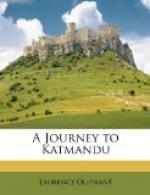At last our patience was rewarded, and Jung gave the signal for us to advance.
On each elephant there were now two riders, the mahout and a man behind, who, armed with a piece of hard wood into which two or three spikes were inserted, hammered the animal about the root of the tail as with a mallet. He was furnished with a looped rope to hold on by, and a sack stuffed with straw to sit upon, and was expected to belabour the elephant with one hand while he kept himself on its back with the other.
This was the position I filled on this trying occasion; but my elephant fared well as regarded the instrument of torture, for I was much too fully occupied in taking care of myself to think of using it. Away we went at full speed, jostling one another up banks and through streams, and I frequently was all but jolted off the diminutive sack which ought to have formed my seat, but did not, for I found it impossible to sit. Being quite unable to maintain any position for two moments together, I looked upon it as a miracle that every bone in my body was not broken. Sometimes I was suddenly jerked into a sitting posture, and, not being able to get my heels from under me in time, they received a violent blow. A moment after I was thrown forward on my face, only righting myself in time to see a huge impending branch, which I had to escape by slipping rapidly down the crupper, taking all the skin off my toes in so doing, and, what would have been more serious, the branch nearly taking my head off if I did not stoop low enough. When I could look about me, the scene was most extraordinary and indescribable: a hundred elephants were tearing through the jungle as rapidly as their unwieldy forms would let them, crushing down the heavy jungle in their headlong career, while their riders were gesticulating violently, each man punishing his elephant, or making a bolster of himself as he flung his body on one side or the other to avoid branches; while some, Ducrow-like, and confident in their activity, were standing on the bare backs of their elephants, holding only by the looped rope,—a feat I found easy enough in the open country, but fearfully dangerous in the jungle. A few yards in front of us was a wild elephant with her young one, both going away in fine style, the pace being 8 or 9 miles an hour. I was just beginning to appreciate the sport, and was contemplating hammering my elephant so as to be up amongst the foremost, when we, in company with about half a dozen others, suddenly disappeared from the scene. A nullah, or deep drain, hidden in the long grass, had engulfed elephants and riders. The suddenness of the shock unseated me, but fortunately I did not lose my hold of the rope, and more fortunately still my elephant did not roll over, but, balancing himself on his knees, with the assistance of his trunk, made a violent effort, and succeeded in getting out of his uncomfortable position.




